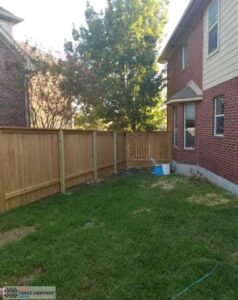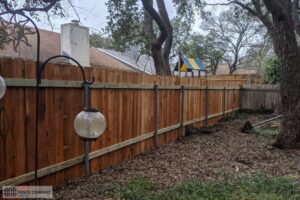Post Depth & Concrete for Austin Soils: The Spec Homeowners Should Demand
Austin’s fences fail most often at the ground line—not in the middle of a panel. The fix isn’t magic wood; it’s correct embedment depth, proper footing geometry, crowned concrete, and drainage that dries the post pocket after every storm. In clay, think deeper sockets with gravel beds and crowned collars. In limestone belts, think core-drilling to achieve depth rather than stopping shallow. Gate posts get bigger sections and better concrete geometry. Demand these details in writing and you’ll keep lines straight, gates square, and stain schedules predictable.
Table of Contents
ToggleWhy post depth matters more in Austin
The force that bends panels and tilts posts here is a combo of water and movement. Expansive clays swell when wet and shrink when dry—that pumping action loosens a flat-topped footing like a cork in a bottle. West and northwest neighborhoods hit limestone shelves that tempt installers to quit early and “foam it in” or pour a shallow plug; a year later the corner rocks. If you lock in correct depth and give water somewhere to go, the fence stays quiet through storms and summer heat.
With guidance from your Austin fence team in the planning phase, you can specify post depth and footing geometry that match your yard—not a generic template.
Austin soils in plain English: clay, limestone, and mixed lots

- Expansive clays (east of MoPac, pockets in Round Rock, Pflugerville, and South Austin): Soils swell after rain and contract in heat. If water lingers at the post, the socket “pumps,” loosening the set. Solution: deeper embedment, gravel base, and a crowned collar that sheds water.
- Shallow limestone (Westlake, Northwest Hills, parts of Bee Cave/Steiner): You may hit rock at 12–20″. Stopping there guarantees a lever arm. Solution: core-drill 8–12″ into the rock and grout the post for lateral strength.
- Transitional/mixed: One stretch digs like butter, the next hits rubble. You need a spec that adapts hole-by-hole instead of forcing one depth everywhere.
The “demand spec” you can hand to any estimator
Copy/paste this into your estimate request and add it to your contract scope.
Posts & sizes
- Privacy runs: 4×4 nominal minimum; 4×6 at corners, gates, and step transitions.
- Metal posts: galvanized schedule-rated steel sized for load and height; no mystery wall thickness.
- Gate leaves >42″ wide: steel-framed gate leaf, not lumber-only.
Embedment depth (top-of-collar to post tip)
- Fence height ≤6 ft: minimum 30–36″ in clay; 36″ target is safer on west/windy exposures.
- Fence height 7–8 ft: 36–42″ in clay.
- Where limestone is hit shallow (<24″): core-drill 8–12″ into competent rock; no “short holes.”
- Frost is not the driver here; wind, water, and soil swell are.
Hole geometry
- Diameter: 3× post thickness or 10–12″ for 4×4—whichever is larger. Larger at gate/corner posts.
- Bell or collar flare above grade: create a crowned top 1–2″ above grade that slopes away from wood/steel.
Gravel bed & drainage
- 6–8″ of compacted, clean ¾” rock at the bottom of every hole. No fines.
- In clay, a geotextile “burrito” around the rock zone prevents soil migration.
Concrete & set
- Concrete from bottom up to eliminate voids; rod/vibrate lightly.
- Finish with a crowned collar; never flat “birdbaths”.
- No encasing wood below grade in a bathtub; keep the wood-concrete interface shedding water.
- Cure time: allow realistic set time before panel hanging, especially after big rains.
Quality checks
- String the line twice (ground line and top line).
- Verify plumb on two faces and in plane with the run; sight every third post.
- Record embedment depth and core-drill locations in the job notes.
If you’re building new, align these details with your fence installation plan in Austin so post spacing, heights, and footing sizes all support wind and drainage—no after-the-fact fixes.
Concrete that helps (and mix details that hurt)
What works
- Standard bag mix or ready-mix brought to proper slump, placed from the bottom up.
- Slightly crowned finish that rides 1–2″ above surrounding grade and sheds water in all directions.
- Where rock is shallow: non-shrink grout in the core-drilled limestone socket, then a conventional collar above.
What hurts
- Dry-packing a hole with hose water sprinkled in—voids guaranteed.
- Over-wetting mixes so they bleed and shrink, pulling off the post.
- Flat collars that trap water against wood or steel.
- Foam only in structural posts—not a substitute for proper embedment.
Tip: in saturated clay, pre-drain the hole with a shop pump or bailer. If water continues to infiltrate, form a short tube (sonotube section) above the waterline and place concrete in the form after stabilizing the base.
Drainage at the fence toe: keep pockets dry

Footings don’t live in isolation—they live in runoff.
- Maintain a 2–3″ base gap under bottom boards/rot boards so splash doesn’t wick into wood.
- Add a 6–12″ decomposed-granite (DG) toe band along runs to keep the toe dry and clean.
- On uphill sides, cut a shallow swale so sheet flow travels along the yard—not through your post pockets.
- Downspout extensions should land past the fence toe; splash blocks alone don’t help in cloudbursts.
- At dips, use rock curbs that close daylight without damming flow.
For a deeper dive into how water shapes your fence’s lifespan, this explainer pairs perfectly with your footing spec: read the quick guide to fence drainage in Austin—it shows where a simple swale or DG toe band prevents lean and rot (related: drainage tips for fence lines in Austin).
Gate and corner posts: overbuild the load points
Gates and corners collect loads that straight runs distribute.
- Lumber size: 4×6 posts at gate bays and corners; wider leaves may warrant steel posts.
- Embedment: go to the next depth tier at gate posts (e.g., 42″ in clay on a 6′ fence) and increase hole diameter.
- Threshold: pour a small broomed-concrete pad pitched away from hinges so the leaf never drags mud.
- Hardware: use adjustable, heavy-duty hinges on a rigid steel gate frame; tune barrels inline to avoid twist.
- Latch placement: keep the grab point out of brutal west sun where possible, both for comfort and finish life.
If an existing gate bay is racking or the leaf is twisting, don’t just shim hinges—plan targeted structural fixes with proper collars and post depths through fence repair service in Austin so you’re not back to square one next summer.
Slopes, wind, and pool zones
- Slopes: Step panels; keep the effective height consistent. Close low daylight with rock curbs or skirt mesh but leave weeps for runoff.
- Wind fetch: Long, unbroken privacy runs act like sails. Add hidden control joints or alternate framing sections to break the span without looking patchy.
- Pool & child safety: Self-closing, self-latching gates are only reliable when posts stay plumb; overbuild those footings and keep thresholds flat, pitched, and non-slick.
Timeline: what a proper footing day looks like
Walk & mark (30–45 minutes)
Confirm utilities and irrigation flags. Mark post centers, swales, and downspout extensions.
Probe & drill (2–4 hours)
- Test for limestone; switch to core-drill where needed.
- In clay, dig 30–42″ depending on fence height and exposure.
Base prep (1–2 hours)
Place 6–8″ compacted clean rock; line with geotextile in fat clays.
Set & pour (2–4 hours)
- Brace posts plumb on two faces; place concrete bottom-up; rod lightly for consolidation.
- Finish crowned collars 1–2″ above grade.
Cure & re-check
Allow realistic set time; re-verify plumb and line before hanging panels.
Common mistakes to reject on your walkthrough

- Flat-topped collars (ask to bevel immediately).
- No gravel base in clay holes.
- Shallow stops at limestone with no core-drilling.
- Short posts cut to reach a shallow hole depth.
- Dipped bottom boards that touch soil.
- Gate leaf hung before the threshold pad sets or without final hinge alignment.
Bring a small level and ask to sight the line every third post; you’re not nitpicking—you’re protecting your investment.
FAQs
Aim for 36″ embedment with a gravel bed and a crowned collar. If the yard is very wind-exposed, push deeper or widen hole diameter at corners and gates.
No. Core-drill an additional 8–12″ into competent limestone and set the post with non-shrink grout; then form a standard collar above grade.
Better geometry beats more volume. A modest bell and a crowned top that sheds water will outperform a bigger, flat bathtub.
Foam has niche uses but is not a substitute for correct embedment depth and drainage-friendly collars on structural posts.
Add a DG toe band 6–12″ wide, keep a 2–3″ base gap, re-grade small swales, and push downspouts past the fence line.
Build Fence Footings That Outlast Austin’s Soil
Want footings that can handle Austin’s clay swells, limestone shelves, and heavy August downpours? We’ll probe your soil, specify proper embedment depths, core-drill where needed, and build crowned, draining collars that keep posts plumb for the long haul. Get a footing-smart fence estimate today or call (512) 366-8108.
